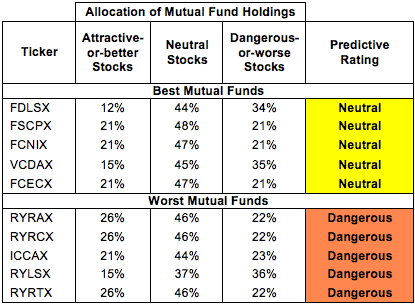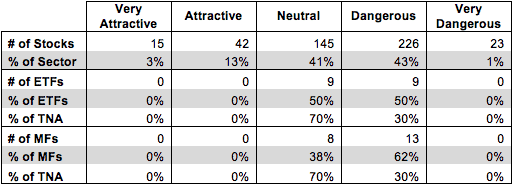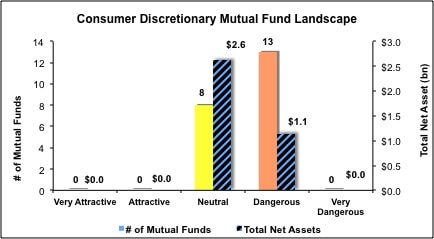Best & Worst ETFs & Mutual Funds: Consumer Discretionary Sector
The Consumer Discretionary sector ranks third out of the ten sectors as detailed in my Sector Rankings for ETFs and Mutual Funds report. It gets my Neutral rating, which is based on aggregation of ratings of 18 ETFs and 21 mutual funds in the Consumer Discretionary sector as of January 13, 2014. Prior reports on the best & worst ETFs and mutual funds in every sector are here.
Figure 1 ranks from best to worst the ten Consumer Discretionary ETFs that meet our liquidity standards and Figure 2 ranks from best to worst the ten Consumer Discretionary mutual funds that meet our liquidity standards. Not all Consumer Discretionary sector ETFs and mutual funds are created the same. The number of holdings varies widely (from 25 to 372), which creates drastically different investment implications and ratings. The best ETFs and mutual funds allocate more value to Attractive-or-better-rated stocks than the worst ETFs and mutual funds, which allocate too much value to Neutral-or-worse-rated stocks.
To identify the best and avoid the worst ETFs and mutual funds within the Consumer Discretionary sector, investors need a predictive rating based on (1) stocks ratings of the holdings and (2) the all-in expenses of each ETF and mutual fund. Investors need not rely on backward-looking ratings. My fund rating methodology is detailed here.
Investors should not buy any Consumer Discretionary ETFs or mutual funds because none get an Attractive-or-better rating. If you must have exposure to this sector, you should buy a basket of Attractive-or-better rated stocks and avoid paying undeserved fund fees. Active management has a long history of not paying off.
Get my ratings on all ETFs and mutual funds in this sector on my free mutual fund and ETF screener.
Figure 1: ETFs with the Best & Worst Ratings – Top 5
 * Best ETFs exclude ETFs with TNAs less than $100 million for inadequate liquidity.
* Best ETFs exclude ETFs with TNAs less than $100 million for inadequate liquidity.
Sources: New Constructs, LLC and company filings
PowerShares Dynamic Retail (PMR), PowerShares Dynamic Consumer Discretionary (PEZ) and Fidelity MSCI Consumer Discretionary Index ETF (FDIS) are excluded from Figure 1 because its total net assets (TNA) are below $100 million and do not meet our liquidity standards.
Figure 2: Mutual Funds with the Best & Worst Ratings – Top 5
 * Best mutual funds exclude funds with TNAs less than $100 million for inadequate liquidity.
* Best mutual funds exclude funds with TNAs less than $100 million for inadequate liquidity.
Sources: New Constructs, LLC and company filings
ICON Funds: ICON Consumer Discretionary Fund (ICCCX) is excluded from Figure 2 because its total net assets (TNA) are below $100 million and do not meet our liquidity standards.
State Street SPDR Consumer Discretionary Select Sector SPDR (XLY) is my top-rated Consumer Discretionary ETF and Fidelity Select Portfolios: Leisure Portfolio (FDLSX) is my top-rated Consumer Discretionary mutual fund. Both earn my Neutral rating.
iShares U.S. Home Construction ETF (ITB) is my worst-rated Consumer Discretionary ETF and Rydex Series Funds: Retailing Fund (RYRTX) is my worst-rated Consumer Discretionary mutual fund. Both earn my Dangerous rating.
Figure 3 shows that 57 out of the 451 stocks (over 15% of the market value) in Consumer Discretionary ETFs and mutual funds get an Attractive-or-better rating. However, no Consumer Discretionary ETFs or mutual funds get an Attractive-or-better rating.
The takeaways are/is: mutual fund managers allocate too much capital to low-quality stocks and Consumer Discretionary ETFs hold poor quality stocks.
Figure 3: Consumer Discretionary Sector Landscape For ETFs, Mutual Funds & Stocks
 Sources: New Constructs, LLC and company filings
Sources: New Constructs, LLC and company filings
As detailed in “Cheap Funds Dupe Investors”, the fund industry offers many cheap funds but very few funds with high-quality stocks, or with what I call good portfolio management.
Investors need to tread carefully when considering Consumer Discretionary ETFs and mutual funds, as no Consumer Discretionary ETFs or mutual funds earn an Attractive-or-better rating. With so many Dangerous-rated funds and no Attractive-rated ones, investors would be better off by focusing on individual stocks instead.
McDonald’s Corporation (MCD) is one of my favorite stocks held by Consumer Discretionary ETFs and mutual funds and earns my Attractive rating. The McDonald’s Corporation has grown after-tax profits (NOPAT) by 12% compounded annually over the last 10 years and earns a top-quintile return on invested capital (ROIC) of 16%. The company has also generated positive and increasing economic earnings for the past 11 years. As I wrote last summer, MCD is surprisingly cheap for a company with such a strong track record of growth. At its current valuation of ~$95/share, MCD has a price to economic book value ratio of only 1. This ratio implies that MCD will never grow NOPAT from its current level. MCD should easily surpass these pessimistic expectations and reward investors.
Callaway Golf Company (ELY) is one of my least favorite stocks held by Consumer Discretionary ETFs and mutual funds and earns my Very Dangerous rating. ELY was recently in the Danger Zone. Callaway Golf Company had decreasing NOPAT of 12% compounded annually over the last four years and is earning a bottom quintile ROIC of -9%. The company has also generated negative and inconsistent economic earnings for the past 10 years.
ELY has a long way to go to justify its valuation of ~$8/share. If ELY can regain a NOPAT margin of 2%, it would need to grow revenue by 20% compounded annually for 16 years. By that point, ELY would have over $15 billion in annual revenue. That’s more than The Gap (GPS) currently makes. To justify ELY’s current valuation, you have to believe the company’s revenues will exceed The GAPs 2012 revenues within a decade and a half. That feat doesn’t seem likely to me given ELY’s much narrower product offerings and demographic focus.
450 stocks of the 3000+ I cover are classified as Consumer Discretionary stocks, but due to style drift, Consumer Discretionary ETFs and mutual funds hold 451 stocks.
Figures 4 and 5 show the rating landscape of all Consumer Discretionary ETFs and mutual funds.
My Sector Rankings for ETFs and Mutual Funds report ranks all sectors and highlights those that offer the best investments.
Figure 4: Separating the Best ETFs From the Worst ETFs
 Sources: New Constructs, LLC and company filings
Sources: New Constructs, LLC and company filings
Figure 5: Separating the Best Mutual Funds From the Worst Mutual Funds
 Sources: New Constructs, LLC and company filings
Sources: New Constructs, LLC and company filings
Review my full list of ratings and rankings along with reports on all 18 ETFs and 21 mutual funds in the Consumer Discretionary sector.
David Trainer and Sam McBride receive no compensation to write about any specific stock, sector, or theme.



